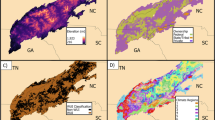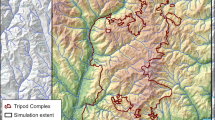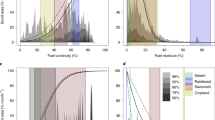Abstract
Climate change is projected to dramatically increase boreal wildfire activity, with broad ecological and socioeconomic consequences. As global temperatures rise, periods with elevated fire weather are expected to increase in frequency and duration, which would be expected to increase the number and size of fires. Statistical forecasts or simulations of future fire activity often account for direct climatic effects only, neglecting other controls of importance, such as biotic feedbacks. This could result in overestimating the effects of climate change on fire activity, if the future distribution of vegetation or fuels were to change. We incorporated sensitivity to climate or fire weather and vegetation in a fire simulation model and represented explicitly two key biotic feedbacks linked to succession and regeneration processes. We used this model to forecast annual fire activity from 2011 to 2099 over a large region of boreal forest in Québec, Canada, dominated by balsam fir (Abies balsamea (L.) Mill) and yellow birch (Betula alleghaniensis Britt.) or paper birch (Betula papyrifera Marsh.), with and without the biotic feedbacks. Our simulations show that vegetation changes triggered by fire disturbance altered future fire activity and may even be as important a driver as climate change itself. Indeed, over the course of the century, vegetation changes were projected to offset much of the increase in fire activity that would be expected due to global warming as such. It follows that if biotic feedbacks are not included in statistical or simulation-based forecasts, the resultant projections of future fire activity could be biased upward to a very considerable degree. For the case of end-of-century mean annual burn rate, we estimated this positive bias to be as high as 400%. Accounting for biotic feedbacks in simulation models is therefore necessary for accurate projection of future wildfire activity and associated vegetation changes. Purely statistical forecasts based on current vegetation cannot be relied upon, in the presence of biotic feedbacks. Our results further suggest that vegetation management could reduce fire risk in some systems by altering the abundance and distribution of the most highly flammable fuels and thus mitigate the impact of climate change on fire activity.





Similar content being viewed by others
References
Appenzeller T. 2015. The new North. Science (80-) 349:806–9.
Armstrong G, Cumming S. 2003. Estimating the cost of land base changes due to wildfire using shadow prices. For Sci 49:719–30.
Astrup R, Bernier PY, Genet H, Lutz DA, Bright RM. 2018. A sensible climate solution for the boreal forest. Nat Clim Change 8:11–12. https://doi.org/10.1038/s41558-017-0043-3.
Baker M. 2016. 1,500 scientists lift the lid on reproducibility. Nature 533:452–4.
Barros AMG, Pereira JMC. 2014. Wildfire selectivity for land cover type: does size matter? PLoS ONE 9:e84760.
Beckage B, Platt WJ, Gross LJ. 2009. Vegetation, Fire, and Feedbacks: A Disturbance-Mediated Model of Savannas. Am Nat 174:805–18. http://www.journals.uchicago.edu/doi/10.1086/648458.
Belleau A, Leduc A, Lecomte N, Bergeron Y. 2011. Forest succession rate and pathways on different surface deposit types in the boreal forest of northwestern Quebec. Écoscience 18:329–40.
Bergeron Y, Chen HYH, Kenkel NC, Leduc AL, Macdonald SE. 2014. Boreal mixedwood stand dynamics: ecological processes underlying multiple pathways. For Chron 90:202–13.
Bernier P, Gauthier S, Jean P-O, Manka F, Boulanger Y, Beaudoin A, Guindon L. 2016. Mapping local effects of forest properties on fire risk across Canada. Forests 7:157.
Boucher Y, Grondin P. 2012. Impact of logging and natural stand-replacing disturbances on high-elevation boreal landscape dynamics (1950–2005) in eastern Canada. For Ecol Manag 263:229–39.
Boucher Y, Grondin P, Auger I. 2014. Land use history (1840–2005) and physiography as determinants of southern boreal forests. Landsc Ecol 29:437–50.
Bowman DMJS, Balch J, Artaxo P, Bond WJ, Cochrane MA, D’Antonio CM, DeFries R, Johnston FH, Keeley JE, Krawchuk MA, Kull CA, Mack M, Moritz MA, Pyne S, Roos CI, Scott AC, Sodhi NS, Swetnam TW. 2011. The human dimension of fire regimes on Earth. J Biogeogr 38:2223–36.
Bowman DMJS, Balch JK, Artaxo P, Bond WJ, Carlson JM, Cochrane MA, D’Antonio CM, Defries RS, Doyle JC, Harrison SP, Johnston FH, Keeley JE, Krawchuk MA, Kull C, Marston JB, Moritz M, Prentice IC, Roos CI, Scott AC, Swetnam TW, van der Werf GR, Pyne SJ. 2009. Fire in the Earth system. Science (80-) 324:481–4.
Bowman DMJS, Murphy BP, Williamson GJ, Cochrane MA. 2014. Pyrogeographic models, feedbacks and the future of global fire regimes. Glob Ecol Biogeogr 23:821–4.
Burnham K, Anderson D. 2002. Model selection and multimodel inference: a practical information-theoretic approach. New York, USA: Springer-Verlag.
Chen H, Popadiouk R. 2002. Dynamics of North American boreal mixedwoods. Environ Rev 166:137–66.
Chubaty AM, McIntire EJB. 2016. SpaDES: Develop and run spatially explicit discrete event simulation models. https://github.com/PredictiveEcology/SpaDES. Last accessed 23/07/2016.
CIFFC. 2003. Glossary of forest fire management terms. Winnipeg, Manitoba. Retrieved from https://www.salmonarmmuseum.org/docs/2003_fire_glossary.pdf. Last accessed 10/05/2019.
Clark JS. 2001. Ecological forecasts: an emerging imperative. Science (80-) 293:657–60.
Cumming SG. 2001a. A parametric model of the fire-size distribution. Can J For Res 31:1297–303.
Cumming SG. 2001b. Forest type and wildfire in the Alberta boreal mixedwood: what do fires burn? Ecol Appl 11:97–110.
Danneyrolles V, Arseneault D, Bergeron Y. 2016. Pre-industrial landscape composition patterns and post-industrial changes at the temperate-boreal forest interface in western Quebec, Canada. J Veg Sci 27:470–81.
Evans MR, Bithell M, Cornell SJ, Dall SRX, Diaz S, Emmott S, Ernande B, Grimm V, Hodgson DJ, Lewis SL, Mace GM, Morecroft M, Moustakas A, Murphy E, Newbold T, Norris KJ, Petchey O, Smith M, Travis JMJ, Benton TG. 2013. Predictive systems ecology. Proc R Soc B Biol Sci 280:20131452.
Falk DA, Heyerdahl EK, Brown PM, Farris C, Fulé PZ, McKenzie D, Swetnam TW, Taylor AH, Van Horne ML. 2011. Multi-scale controls of historical forest-fire regimes: new insights from fire-scar networks. Front Ecol Environ 9:446–54.
Finney MA. 2004. FARSITE: Fire area simulator—model development and evaluation. US Department of Agriculture, Forest Service, Rocky Mountain Research Station Ogden, UT
Gauthier S, Bernier P, Kuuluvainen T, Shvidenko AZ, Schepaschenko DG. 2015. Boreal forest health and global change. Science (80-) 349:819–22.
Girardin MP, Ali AA, Carcaillet C, Blarquez O, Hély C, Terrier A, Genries A, Bergeron Y. 2013. Vegetation limits the impact of a warm climate on boreal wildfires. New Phytol 199:1001–11.
Girardin MP, Terrier A. 2015. Mitigating risks of future wildfires by management of the forest composition: an analysis of the offsetting potential through boreal Canada. Clim Change 130:587–601.
Gonzalez P, Neilson RP, Lenihan JM, Drapek RJ. 2010. Global patterns in the vulnerability of ecosystems to vegetation shifts due to climate change. Glob Ecol Biogeogr 19:755–68.
Gottschalk PG, Dunn JR. 2005. The five-parameter logistic: a characterization and comparison with the four-parameter logistic. Anal Biochem 343:54–65.
Gouvernement du Québec. 2014. Climate of Québec. http://www.gouv.qc.ca/EN/LeQuebec/Pages/Geographie.aspx. Last accessed 07/05/2018
Grimm V, Revilla E, Berger U, Jeltsch F, Mooij WM, Railsback SF, Thulke H-H, Weiner J, Wiegand T, DeAngelis DL. 2005. Pattern-oriented modeling of agent-based complex systems: lessons from ecology. Science 310:987–91.
Hantson S, Pueyo S, Chuvieco E. 2015. Global fire size distribution is driven by human impact and climate. Glob Ecol Biogeogr 24:77–86.
Hargrove WW, Gardner RH, Turner MG, Romme WH, Despain DG. 2000. Simulating fire patterns in heterogeneous landscapes. Ecol Model 135:243–63.
Hély C, Bergeron Y, Flannigan MD. 2000. Effects of stand composition on fire hazard in mixed-wood Canadian boreal forest. J Veg Sci 11:813–24.
Heon J, Arseneault D, Parisien M-A. 2014. Resistance of the boreal forest to high burn rates. Proc Natl Acad Sci 111:13888–93.
Ilisson T, Chen HYH. 2009. Response of six boreal tree species to stand replacing fire and clearcutting. Ecosystems 12:820–9.
IPCC. 2014. Climate change 2014: impacts, adaptation, and vulnerability. Part A: global and sectoral aspects. Contribution of working group II to the fifth assessment report of the intergovernmental panel on climate change. (Field CB, Barros VR, Dokken DJ, Mach KJ, Mastrandrea MD, Bilir TE, Chatterjee M, Ebi KL, Estrada YO, Genova RC, Girma B, Kissel ES, Levy AN, MacCracken S, Mastrandrea PR, White LL, editors.). Cambridge University Press, Cambridge, United Kingdom and New York, NY, USA
Johnstone JF, McIntire EJB, Pedersen EJ, King G, Pisaric MJF. 2010. A sensitive slope: estimating landscape patterns of forest resilience in a changing climate. Ecosphere 1:art14.
Johnstone JF, Rupp TS, Olson M, Verbyla D. 2011. Modeling impacts of fire severity on successional trajectories and future fire behavior in Alaskan boreal forests. Landsc Ecol 26:487–500. http://link.springer.com/10.1007/s10980-011-9574-6.
Keane R. 2004. A classification of landscape fire succession models: spatial simulations of fire and vegetation dynamics. Ecol Model 179:3–27.
Kelly R, Chipman ML, Higuera PE, Stefanova I, Brubaker LB, Hu FS. 2013. Recent burning of boreal forests exceeds fire regime limits of the past 10,000 years. Proc Natl Acad Sci 110:13055–60. http://www.pnas.org/cgi/doi/10.1073/pnas.1305069110. Last accessed 28/02/2014
Krawchuk MA, Cumming SG. 2011. Effects of biotic feedback and harvest management on boreal forest fire activity under climate change. Ecol Appl 21:122–36.
Krawchuk MA, Cumming SG, Flannigan MD, Wein RW. 2006. Biotic and abiotic regulation of lightning fire initiation in the mixedwood boreal forest. Ecology 87:458–68. http://www.ncbi.nlm.nih.gov/pubmed/16637370. Last accessed 24/03/2013
Krawchuk MA, Moritz MA. 2014. Burning issues: statistical analyses of global fire data to inform assessments of environmental change. Environmetrics 25:472–81.
Loarie SR, Duffy PB, Hamilton H, Asner GP, Field CB, Ackerly DD. 2009. The velocity of climate change. Nature 462:1052–5.
MacArthur RH. 1958. A note on stationary age distributions in single-species populations and stationary species populations in a community. Ecology 39:146.
Marchal J, Cumming SG, McIntire EJB. 2017a. Exploiting Poisson additivity to predict fire frequency from maps of fire weather and land cover in boreal forests of Québec, Canada. Ecography (Cop) 40:200–9.
Marchal J, Cumming SG, McIntire EJB. 2017b. Land cover, more than monthly fire weather, drives fire-size distribution in Southern Québec forests: Implications for fire risk management. PLoS ONE 12:e0179294.
McKenney DW, Hutchinson MF, Papadopol P, Lawrence K, Pedlar J, Campbell K, Milewska E, Hopkinson RF, Price D, Owen T. 2011. Customized spatial climate models for North America. Bull Am Meteorol Soc 92:1611–22.
Ministère des Ressources naturelles. 2013. Norme de stratification écoforestière. Québec, QC, Canada: Quatrième inventaire écoforestier du Québec méridional.
Morales JM, Mermoz M, Gowda JH, Kitzberger T. 2015. A stochastic fire spread model for north Patagonia based on fire occurrence maps. Ecol Model 300:73–80. https://doi.org/10.1016/j.ecolmodel.2015.01.004.
Mullen K, Ardia D, Gil D, Windover D, Cline J. 2011. DEoptim: an R package for global optimization by differential evolution. J Stat Softw 40:1–26.
Parisien M-A, Parks SA, Krawchuk MA, Little JM, Flannigan MD, Gowman LM, Moritz MA. 2014. An analysis of controls on fire activity in boreal Canada: comparing models built with different temporal resolutions. Ecol Appl 24:1341–56.
Parks SA, Holsinger LM, Miller C, Nelson CR. 2015. Wildland fire as a self-regulating mechanism: the role of previous burns and weather in limiting fire progression. Ecol Appl 25:1478–92.
Parks SA, Parisien M-A, Miller C. 2012. Spatial bottom-up controls on fire likelihood vary across western North America. Ecosphere 3:art12.
Peters DPC, Pielke RA, Bestelmeyer BT, Allen CD, Munson-McGee S, Havstad KM. 2004. Cross-scale interactions, nonlinearities, and forecasting catastrophic events. Proc Natl Acad Sci USA 101:15130–5.
R Core Team. 2015. R: A language and environment for statistical computing. https://www.r-project.org/. Last accessed 25/01/2016.
Robitaille A, Saucier J-P. 1998. Paysages régionaux du Québec méridional. Sainte-Foy, Québec, Canada: Les Publications du Québec.
Seidl R, Thom D, Kautz M, Martin-Benito D, Peltoniemi M, Vacchiano G, Wild J, Ascoli D, Petr M, Honkaniemi J, Lexer MJ, Trotsiuk V, Mairota P, Svoboda M, Fabrika M, Nagel TA, Reyer CPO. 2017. Forest disturbances under climate change. Nat Clim Chang 7:395–402. https://doi.org/10.1038/nclimate3303.
Taylor AR, Chen HYH. 2011. Multiple successional pathways of boreal forest stands in central Canada. Ecography (Cop) 34:208–19.
Taylor KE, Stouffer RJ, Meehl GA. 2012. An overview of CMIP5 and the experiment design. Bull Am Meteorol Soc 93:485–98.
Thiele JC, Grimm V. 2015. Replicating and breaking models: good for you and good for ecology. Oikos 124:691–6.
Tymstra C, Bryce RW, Wotton BM, Taylor SW, Armitage OB. 2010. Development and structure of Prometheus: the Canadian wildland fire growth simulation model.
Veraverbeke S, Rogers BM, Goulden ML, Jandt RR, Miller CE, Wiggins EB, Randerson JT. 2017. Lightning as a major driver of recent large fire years in North American boreal forests. Nat Clim Chang 7:529–34. http://www.nature.com/doifinder/10.1038/nclimate3329.
Van Wagner CE. 1987. Development and structure of the Canadian forest fire weather index system. Ottawa: Canada.
Walck JL, Hidayati SN, Dixon KW, Thompson K, Poschlod P. 2011. Climate change and plant regeneration from seed. Glob Chang Biol 17:2145–61.
Yemshanov D, Perera AH. 2002. A spatially explicit stochastic model to simulate boreal forest cover transitions: general structure and properties. Ecol Model 150:189–209.
Zhu K, Woodall CW, Ghosh S, Gelfand AE, Clark JS. 2014. Dual impacts of climate change: forest migration and turnover through life history. Glob Change Biol 20:251–64.
Acknowledgements
Financial support came from the Ouranos Consortium, the Fonds vert du gouvernement du Québec, the Canadian Statistical Sciences Institute, the National Sciences and Engineering Research Council of Canada Discovery Grants program (SGC) and the Canada Research Chair program (SGC and EJBM). We thank T. Logan from the Ouranos Consortium for providing the weather data. Finally, we would like to thank Rupert Seidl and three anonymous reviewers for their helpful and supportive comments.
Author information
Authors and Affiliations
Corresponding author
Additional information
Author’s Contribution
All authors designed the analysis, JM performed the analysis, and all authors contributed to analyzing data and writing of the manuscript.
Electronic supplementary material
Below is the link to the electronic supplementary material.
Rights and permissions
About this article
Cite this article
Marchal, J., Cumming, S.G. & McIntire, E.J.B. Turning Down the Heat: Vegetation Feedbacks Limit Fire Regime Responses to Global Warming. Ecosystems 23, 204–216 (2020). https://doi.org/10.1007/s10021-019-00398-2
Received:
Accepted:
Published:
Issue Date:
DOI: https://doi.org/10.1007/s10021-019-00398-2




